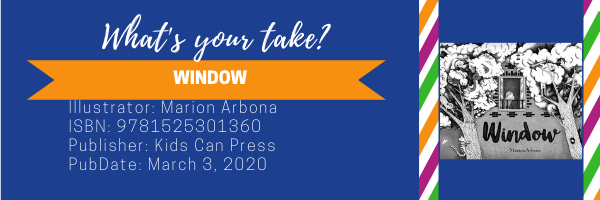Maria V. Acevedo-Aquiño, University of Texas A&M, San Antonio, Desiree W. Cueto, Western Washington University, and Dorea Kleker, University of Arizona
For the third week of July, Mari and Desiree give their takes to Window, a black and white visual narrative.
MARIA: In this black and white wordless book, French Canadian author/illustrator Marion Arbona introduces readers to a child who walks home through a busy neighborhood wondering what lies behind each window. One window takes the child into an intricate indoor jungle, while another one invites the child to swim with mysterious creatures from the deep sea. Each window opens a unique magical world. Sometimes Arbona’s work reminds me of Australian author/illustrator Shaun Tan. Other times, I think about American author/illustrator David Wiesner. The tone of the story is playful and highly creative showing a range of whimsical realities with individual elements that come together in the last double page spread, which showcases the child’s bedroom. What a mentor text to encourage storying!
A few years ago, I would have focused on the playfulness of the book and its power to encourage imagination and wonder. However, reading this book during COVID-19 has made me consider even more who might live behind those windows, and how they experience and cope with their worlds. I think about the countless hours that many children and families have spent at home during the pandemic and how little teachers, neighbors or relatives might know about what is happening behind those windows. Are they okay? Have they lost a loved one? Are they or have they experienced food insecurity? Home insecurity? With the early childhood classroom in my mind I wonder, how can early educators support young children and families to unpack the complex meanings of their unique realities? I think Window can encourage individual stories, shared stories, and stories about hope to help readers embark in this healing journey.
DESIREE: I wholeheartedly agree, Maria, as far as classroom use, Window is ripe with possibilities. It ties beautifully to our text collection on windows in that it asks readers to imagine how someone else might experience the world. Like each of the other books we selected for this conversation, this one begins with the protagonist looking out the window. On the cover she is home and on the first page of the book she appears to be in a classroom. Her facial expression in both settings conveys a sense of wonder and curiosity. Readers are invited to join her as she leaves school and meanders through the neighborhood, wondering about the wild happenings in each of the other homes.
I particularly enjoyed the level of detail in each illustration as well as the element of fantasy. Given that it is a story told solely through pictures, this is significant. Readers of all ages will be able to access the book and add their own imaginative ideas to the reading event. I absolutely feel that the story lends itself to the kind of work in early childhood classrooms that you mentioned. Beyond serving as an invitation to children to share their own experiences, it may also prompt them to think about and question the kinds of things other children do at home, and what their lives may be like outside of school.
Title: Window
Illustrator: Marion Arbona
ISBN: 9781525301360
Publisher: Kids Can Press
PubDate: March 3, 2020
Throughout July 2021, Desiree Cueto, Maria Acevedo-Aquiño, and Dorea Kleker discuss four recently published picturebooks with global connections around the theme of “windows”. Check back each Wednesday to follow the conversation!
- Themes: Desiree Cueto, Dorea Kleker, Maria Acevedo-Aquino, Marion Arbona, Window
- Descriptors: Books & Resources, My Take/Your Take

